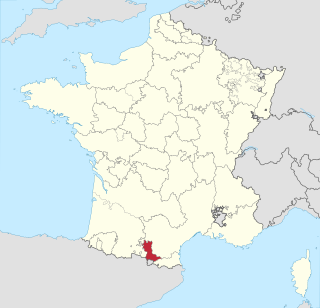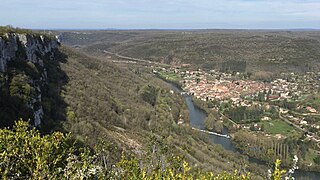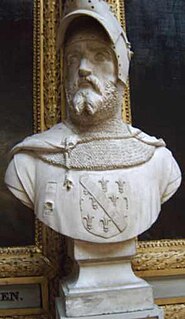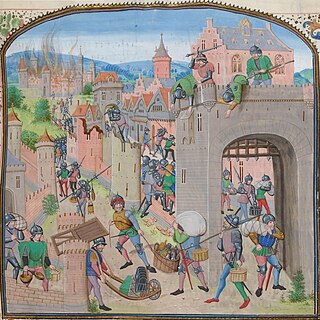

Bertucat d'Albret was a medieval mercenary leader of a bandit army in the Hundred Years' War. [1] [2] [3]


Bertucat d'Albret was a medieval mercenary leader of a bandit army in the Hundred Years' War. [1] [2] [3]
Bertucat d'Albret is an illegitimate son of Bernard Ezy IV sire d'Albret, and half-brother of Arnaud-Amanieu, lord of Montcuq.
Bertucat d'Albret fought at the Battle of Poitiers in 1356 and in 1360 after the Treaty of Brétigny, and without employ, he led a band of brigands, in company with Bertucat d'Albret in 1361 into the Languedoc, Roussillon, Toulouse and Rouergue districts.
In 1362, with Bertucat he took Montbrun, plundered Saint-Flour, Cantal then participated with Petit Meschin, at the Battle of Brignais against Jacques de Bourbon Count of La Marche.
In 1363, when most of the brigands went to go to Italy, he returned to plunder the Languedoc area with Petit Meschin, Louis Rabaud, Arnaud du Solis and Espiote, who together took Brioude on 13 September.
He went to Quercy. In 1357 he appeared in Auvergne and occupied Sermur, which served as a base for his expeditions.
In June 1359, he joined forces with Robert Knolles in Pont-du-Château. In 1361, he is with Bérard d'Albret, perhaps his cousin, in Bas-Languedoc.
In August 1361, he joined forces with Seguin de Badefol in front of Narbonne and they invade Roussillon, then the Toulouse.
Rouergue pays a ransom for their departure.
He was defeated at Launac in 1362. He entered Gévaudan with Seguin de Badefol and took Brioude in September.
In 1365, it makes the castle of Blot and invades the Chalonnais with allies from Gascon.
He beat Olivier de Mauny with the troops of the Prince of Wales at La Ville-Dieu-du-Temple, in August 1366, then he went to Castile with the Black Prince's army.
He returned to Quercy in 1369, in Limousin at the beginning of 1371.
He took Figeac in October 1371, but undertook not to attack the region again for 120 000 francs.
He was imprisoned in 1374 and released at the end of 1376.
He left Bergerac in 1377. In reward for his participation in the war of Castile, he received in 1379 the land of Arberoue and the castle of Roquefort.
In 1380, he took Montferrand in March, Chateauneuf-de-Randon, where the Constable Bertrand Du Guesclin died during the siege, and Chaliers in April.
In 1381, he was in England with Robert Knolles in London alongside Richard II during the revolt of Wat Tyler.
In thanks, the king gave him the barony of Caumont-sur-Garonne.
Back in the south of France, the companies of Bertucat d'Albret occupied eight castles in Quercy ordered by two of his lieutenants, Noli Barbe and Bernard Douat. He also had other garrisons in the neighboring provinces, in Gascony, in the Perigord, in the Agenais and Saintonge.
He was taken prisoner during a skirmish in the summer of 1382.
He died in September 1383. Raymond or Ramonet de Sort, who called himself his nephew, succeeded him.

Languedoc is a former province of France. Its territory is now contained in the modern-day region of Occitanie in the south of France. Its capital city was Toulouse. It had an area of approximately 42,700 square kilometers.

Midi-Pyrénées is a former administrative region of France. Since 1 January 2016, it has been part of the new region Occitanie. It was the largest region of Metropolitan France by area, larger than the Netherlands or Denmark.

The Count of Toulouse was the ruler of Toulouse during the 8th to 13th centuries. Originating as vassals of the Frankish kings, the hereditary counts ruled the city of Toulouse and its surrounding county from the late 9th century until 1270. The counts and other family members were also at various times counts of Quercy, Rouergue, Albi, and Nîmes, and sometimes margraves of Septimania and Provence. Count Raymond IV founded the Crusader state of Tripoli, and his descendants were also counts there. They reached the zenith of their power during the 11th and 12th centuries, but after the Albigensian Crusade the county fell to the kingdom of France, nominally in 1229 and de facto in 1271.

The County of Foix was an independent medieval fief in southern France, and later a province of France, whose territory corresponded roughly the eastern part of the modern département of Ariège.

Saint-Antonin-Noble-Val is a commune in the Tarn-et-Garonne department in the Occitanie region in southern France.

Quercy is a former province of France located in the country's southwest, bounded on the north by Limousin, on the west by Périgord and Agenais, on the south by Gascony and Languedoc, and on the east by Rouergue and Auvergne.

James I of Bourbon, was a French prince du sang, and the son of Louis I, Duke of Bourbon and Mary of Avesnes. He was Count of Ponthieu from 1351 to 1360, and Count of La Marche from 1341 to his death.

Brioude is a commune in the Haute-Loire department in the Auvergne-Rhône-Alpes region in south-central France. It lies on the banks of the river Allier, a tributary of the Loire.

The Battle of Brignais was fought on 6 April 1362, between forces of the Kingdom of France under Count Jacques de Bourbon, from whom the later royal Bourbons descend, and the Tard-Venus Free Company, led by Petit Meschin and Seguin de Badefol.
The Treaty of Corbeil was an agreement signed on 11 May 1258, in Corbeil between Louis IX of France and James I of Aragon.

The former Catholic diocese of Mirepoix, in south-west France, was created in 1317 by Pope John XXII from the diocese of Pamiers. It existed until the French Revolution, and was suffragan of the Archbishop of Toulouse. Its see was Mirepoix, Ariège.

The Catholic Diocese of Carcassonne and Narbonne is a diocese of the Latin Rite of the Catholic Church in France. The diocese comprises the entire department of Aude. It is suffragan to the Archdiocese of Montpellier.

Sévérac-le-Château is a former commune in the Aveyron department in southern France. On 1 January 2016, it was merged into the new commune of Sévérac-d'Aveyron.

Penne is a commune in the Tarn department in the Occitanie region in Southern France. In 2018, it had a population of 584. Penne is situated 32 km to the east of Montauban, on the Aveyron River.

A free company was an army of mercenaries between the 12th and 14th centuries recruited by private employers during wars. They acted independently of any government, and were thus "free". They regularly made a living by plunder when they were not employed; in France they were the routiers and écorcheurs who operated outside the highly structured law of arms. The term "free company" is most applied to those companies of soldiers which formed after the Peace of Brétigny during the Hundred Years' War and were active mainly in France, but it has been applied to other companies, such as the Catalan Company and companies that operated elsewhere, such as in Italy and the Holy Roman Empire.

Miss France 1997, the 67th edition of the Miss France pageant, was held on December 13, 1996 at the Futuroscope in Vienne.

Occitanie, Occitany or Occitania, is the southernmost administrative region of metropolitan France excluding Corsica, created on 1 January 2016 from the former regions of Languedoc-Roussillon and Midi-Pyrénées. The Council of State approved Occitanie as the new name of the region on 28 September 2016, coming into effect on 30 September 2016.
Tard-Venus were medieval groups of routiers that ravaged Europe in the later years of the reign of King John II of France.

Seguin de Badefol was a Medieval leader of a large bandit army or Routier With 2000 troops he was the head of the largest group of Tard-Venus.

Le Petit Meschin was a French soldier, mercenary and brigand of the Hundred Years War in the 14th century.